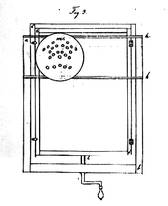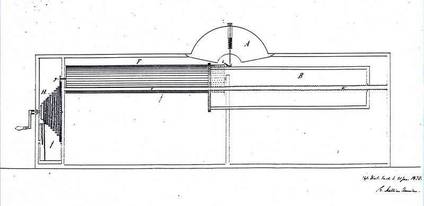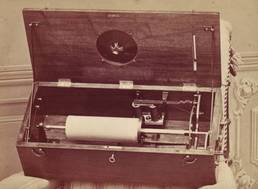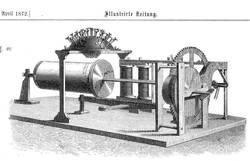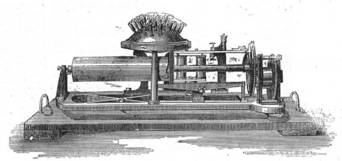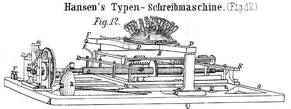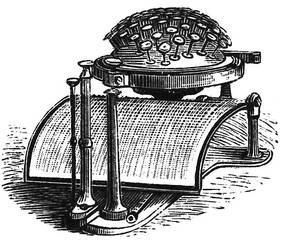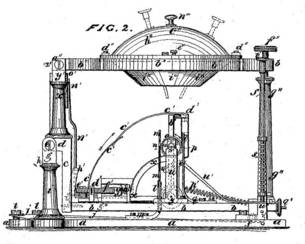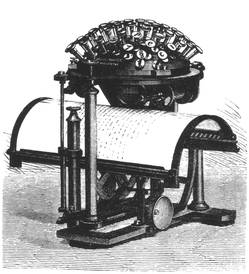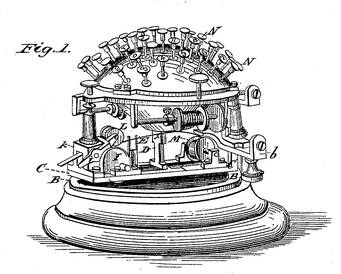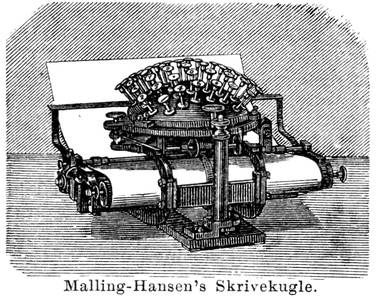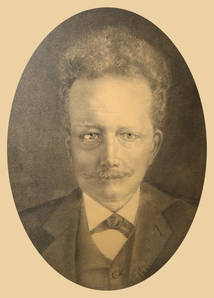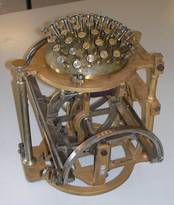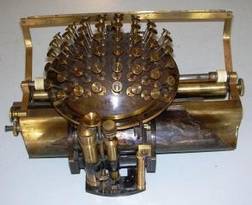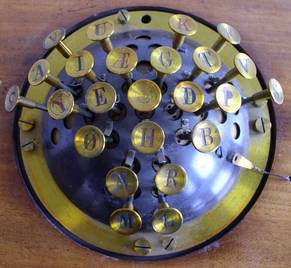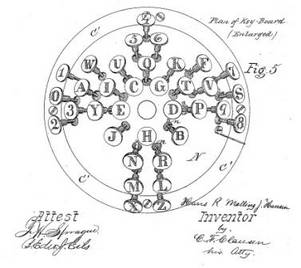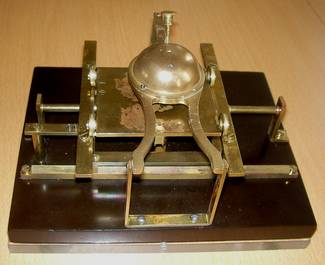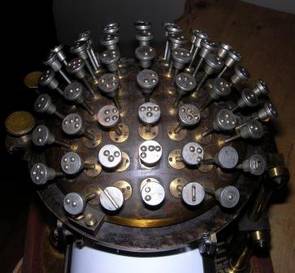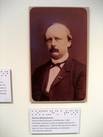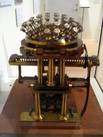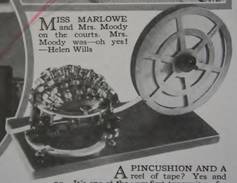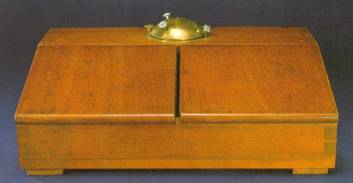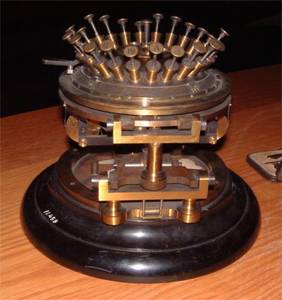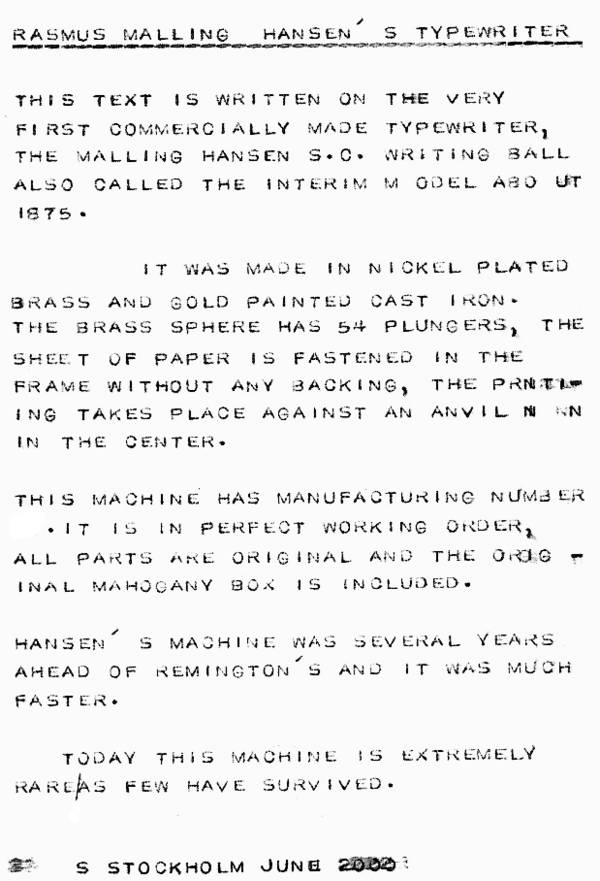All the models

- In the Teknisk Museum in Helsingør in Denmark they have 9 writing balls, and one keyboard. This includes a variaty of models and production-years. There is a sample of the 1870-model with a cylinder and wooden box, and the 1888-model with colour ribbon and paper platen, developed by mechanic Aug. Lyngbye. Photo: Sverre Avnskog
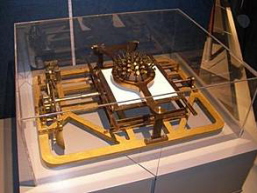
- This sample of the model that was first built in 1871, with a flat carriage for the paper, is the only one that is exhibited in Helsingør. Because of some reason that we not yet know, Malling-Hansen did not number the first writing balls that were built, thus writing ball with production number 1 is a flat model, and today belongs to a museum in Berlin. Photo:Sverre Avnskog
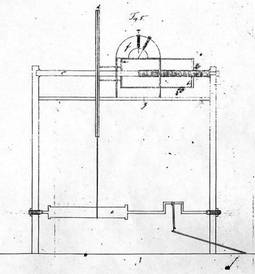
- Most likely this was the first model of the writing ball that was ever built. Several sources stake that the first model weighed 75 kg, and of all the drawings we know, this is the only model that matches this information. It was probably developed between 1867 and 1869.
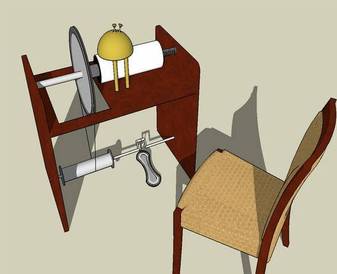
- The model doesn't exist today, but only as patent drawings, and as a computer model made by Dieter Eberwein. There is a great probabillity that this model was shown in Germany in connection with the industry exhibition that was arranged in Altona in 1869. Not as a part of the exhibition but as a private arrangement in Hamburg at a company called “Donner & Co”, according to RMH's daughter Engelke Wiberg.
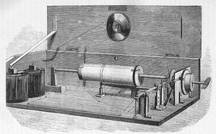
- And then there is the famous box-model. The first box-model, from August 1870, used both electric batteries and a helical spring. The first batteries where inbuilt, and had a great resamblance with the wet batteries developed by Georges Lionel Leclanché, 1839-1882. In 1866 he invented a wet battery that became very popular and was produced in several thousands copies.
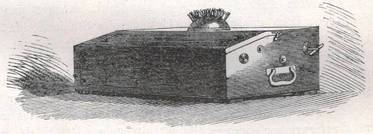
- These batteries were used both in French and Belgian telephone companies. But unfortunately they were not totally reliable and needed much caretaking, and the use of batteries was a constance source of trouble for many writing ball owners. But five years were to pass before RMH found a mechanical replacement.
The development of the writing ball from 1870 to 1888
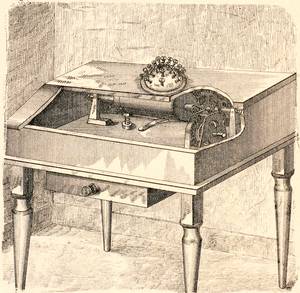
- This is an interesting model of the Writing Ball. It was printed on one of the posters in an American series of more than 200 posters called "The growth of Industrial Art" by Butterworth, 1888. It's not possible to know for sure if the Writing Ball has really existed in exactly this version, or if the illustrator's drawing is loosely based on his memory or descreptions from others. But one can clearly recognize many details from the well known box model and different patent drawings. It seems that this table model is not equipped with a battery.
The writing ball was made in a great variety of different models. Rasmus Malling-Hansen sold his patents in several countries, and we still not have the full general view of the models. But we know that he worked constantly to improve his invention during the 1870's.
On the basis of the known patents, letters and of old articles in newspapers and journals we can list the following years for the launching of the newest developments:
1865-1870: It is a fact that RMH during the five years between 1865 and 1870 developed his ideas of a fast speed printing machine both on the drawing table and as models. Unfortunately we know very few details from this period, but several sources claim that the first writing ball weighed 75 kg, and this fact indicates that the first built model was the large writing ball with a wheel intergrated in a table. The wheel was connected to the paper cylinder, and was set in rotation by a foot pedal. Probably some of the other models from the early patent drawings were also built, and new ideas was launced several times in the early months of 1870. None of these models exist today, unfortunately.
1870: The first "official" model, with battery, paper cylinder and wooden box, using carbon paper was finished. This writing ball was first shown to the Danish press on the 8.th of September 1870 - and already the next day the first newspapers brought reviews of this revolutionary new invention. And soon newspapers and journals abroad also brought articles about this very promising new Danish invention.
1871: The model with flat carriage raplacing the cylinder, but still with a battery, and using carbon paper was first built during this year. Actually the idea was not new, a drawing of the flat carriage was included already in the British patent application in May 1870. A new cylinder-model without the wooden box was also produced this year, and both new models were equipped with a new and improved writing head - now with 52 keys - arranged in a new and better way. Because of some unknown reason, Malling-Hansen didn't number first the writing balls that were produced, so it's actually a flat model that has the production number 1 - this writing ball belongs to a museum in Berlin.
1872: During 1871 Malling-Hansen and his faithful mechanic, prof Jürgensen also developed a totally new "writing ball" - intended for use by stenographers in large assemblies - the takygraf. It worked almost silently, and could be written on in an extremely high speed - upto 1200 strokes in the minute. Because some photos of a takygraf are preserved, we can be sure it was really built in at least one specimen, but unfortunately no takygraf is known to exist today. It is the dream of many Malling-Hansen admireres to trace down a takygraf.....
1875: The well known tall model without battery, but still using carbon paper was first patented this year, and this model was a great step forward when it comes to the practical use of the writing ball. The electomagnetic battery was also a relatively new invention and not very trustable, so Malling-Hansen wanted to find a better, mechanical solution to the movement of the paper after a key had been stroke. It is said that several mechanics tried for a very long time to find out how this could be worked, but all gave up, and so Malling-Hansen himself once again had to make proof of his brilliant mind - he found the solution to the problem, and the writing ball was free of the battery, which had caused a great deal of worrying.
1878: Some years before the great world exhibition in Paris, Malling-Hansen corresponded for a periode with his hardest competitor, "the American" as he called him - James Densmore. Malling-Hansen was eager to sell his patent rights to start production of writing balls in USA, but the bid from Densmore was too low to accept in Malling-Hansen's eyes. Instead Malling-Hansen took great effort in developing his models for the great event in 1878, to proof to everybody that his typewriter was of a far better quality than the Remington typewriter. And we must say that he succeeded in this matter: in Paris he received a gold medal for the typewriter, which was now equipped with a colour ribbon, and the judges and the journalists held his writing ball to be of a much better quality than the Remington machine. But if Malling-Hansen had been able to see into the future, he would see that it would have been a far, far better deal if he had sold the patents rights and started production in USA! That was were the money was - the one thing that Malling-Hansen had far too little of!
In Paris Malling-Hansen also received a silver medal for the writing ball as an educational apparatus for blind people, and I think it's a good guess that two of the models he exhibeted in Paris were with braille and moon alphabet. Totally he had 4 models in Paris, and the last one was a small writing ball on a wooden foot, made to write on paper strips.
1888: The lower modell, sometimes called the "tipp-ball", with colour ribbon and paper platen is often refered to as the 1888-model allthough the first lower prototype was finished as early as 1879. We don't know the details about the developement of this model, but it was probably first built at Jürgensen's workshop. It was a very compact and solid model, and today it is only known to exist in one single copy. So is the very last model that was built by the mechanic August Lyngye, and received the First Price medal on the great Art, Agricultural and Industrial Exhibition in Copenhagen in 1888. In his advertisements Lyngbye offers a writing ball with both small and capitol letters, but no such model has ever been seen. Malling-Hansen had great expectations to this model, and according to information given by Lyngbye's wife to Malling-Hansen's daughter, Johanne Agerskov, Malling-Hansen ordered 100 writing balls for production before he died. But when he suddenly passed away in 1890, the order was cancelled, and no more writing balls were ever made.....
In addition to the above mentioned models, we know that there was also made a mini writing ball, in a 2/3 size. The descendants from Malling-Hansen's daughter, Emma Mathiesen, own such a writing ball, and I have had the great pleasure of trying to write on it. I can promise that it was an unforgettable experience!
Malling-Hansen often started to use his newest developments himself, before they were patented, and we know from letters he wrote that he used a model with colour ribbon already in 1877, even though it was not patented until 1878.
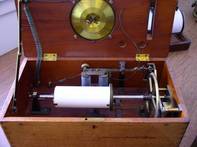
- The 1870 model of the writing ball with a battery, paper cylinder and wooden box. Photo taken in The Teknisk Museum in Helsingør by Dieter Eberwein
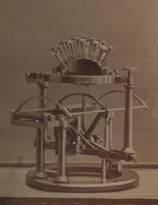
- An old picture of the tall writing ball without colour ribbon, which had to have a carbonized paper on top of the white sheet of paper. Photocopy: Carsten Erik Noe
The development of the keyboard
The keyboard of the writing ball also went through great developments during the years. The first model had only 24 keys - with only the small letters, and without keys for punctuation. The shape of the writing ball remained the same thoug, but increased in size, to make space for 36 and later 52 keys on the last models. There were also some difference between the models for domestic use, with the keys æ and ø, and the models produced abroad, with the alphabet ending with z.
There are still investigations to be made on the matter of the keyboard of the writing ball.
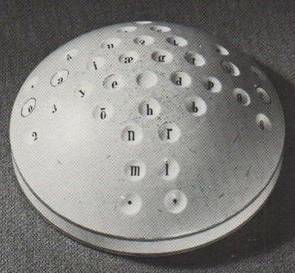
- This porcelain model of a writing ball is in the possession of the Royal Copenhagen in Copenhagen, but not exhibited for the time being. According to the factory museum the porcelain ball was made in 1871, but it is not yet clear what the purpose of the ball was, but probably it was used as a kind of practice-ball. Probably it has great likeness with the porcelain model that Malling-Hansen used in 1865. It has got 36 keys with only the small letters, and we know from the first letters Malling-Hansen wrote that he only used small letters in the beginning. Copyright: Bredo L. Grandjean and Hernov Forlag

- The writing ball model with braille was exhibited during the autumn 2011 on an exhibition at the Post and Tele Museum in Denmark. This writing ball is presently owned by "Medicinsk Museion", Bredgade 62, probably donated by the former Blind Museum.
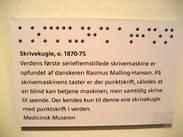
- Along with the writing ball one could also read some information about the machine and its inventor, Rasmus Malling-Hansen. The machine was specially made for the World exhibition in Paris, 1878.
Link to the website of the Post and Tele Museum and the article about the writing ball with braille: http://www.ptt-museum.dk/museumsposten/tidligere_artikler/diverse/?id=185
And to Medical Museion's own website: http://www.corporeality.net/museion/2011/06/08/malling-hansens-braille-writing-ball-on-display/
The writing ball with Braille can also be seen on "youtube": http://www.youtube.com/watch?v=vWP-b4H6AR4
Oslo, 04.11.06
Sverre Avnskog

